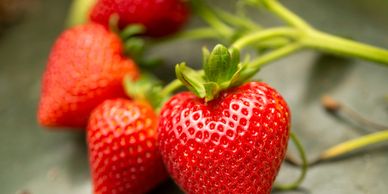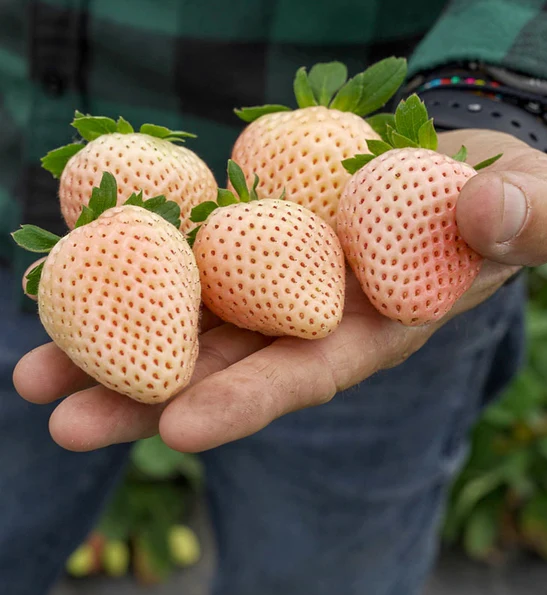If you’re dreaming of picking sweet, juicy strawberries right from your own garden in Florida, choosing the right variety is the key to success. Florida’s warm climate and unique growing season mean not all strawberries will thrive here.
But don’t worry—there are specific strawberry varieties that are perfectly suited to Florida’s weather, promising you flavorful berries that you’ll love to eat fresh or freeze for later. You’ll discover the best strawberry varieties to grow in Florida, along with simple tips to help your plants flourish.
Ready to grow strawberries that burst with flavor and fit perfectly into your Florida garden? Let’s dive in!

Credit: cedarpointnursery.com
Top Strawberry Varieties
Choosing the right strawberry variety boosts your chances of success in Florida’s climate. The best varieties produce sweet, juicy berries that thrive in mild winters. Short-day strawberries work well here because they fruit when daylight is shorter. These varieties give good yields and resist common Florida pests and diseases.
Below are three top varieties that many Florida gardeners prefer. Each one has unique traits suited to local conditions. Learn about their flavor, size, and growth habits to pick the best fit for your garden.
Florida Brilliance
Florida Brilliance is a popular choice among home gardeners. It produces bright red, medium-sized berries with great flavor. The plants are vigorous and adapt well to Florida’s soil. This variety ripens early, letting you enjoy fresh strawberries sooner. It also stores well, making it ideal for freezing or fresh eating.
Camarosa
Camarosa yields large, firm berries with a dark red color. Its fruit holds up well during picking and transport. This variety suits gardeners who want strawberries for fresh use and desserts. Camarosa plants grow upright and spread moderately, covering ground efficiently. They perform well in Florida’s warm winters and tolerate some heat.
Sweet Sensation®
Sweet Sensation® is known for its excellent fruit quality. It produces sweet, juicy berries with a rich aroma. The yield is high, making it a favorite for those wanting plenty of strawberries. Plants show good disease resistance and strong growth. This variety ripens in the mid-season, extending your harvest period.
Planting Schedule
Establishing the right planting schedule is key for growing strawberries in Florida. Timing affects plant health and berry production. Understanding Florida’s unique climate helps choose the best planting moments. Proper scheduling leads to a fruitful harvest during cooler months.
Best Time To Plant In Florida
Plant strawberries in Florida from late October to early December. This period avoids the hot summer heat that harms young plants. Cooler temperatures encourage strong root growth and healthy leaves. Planting too early or late can reduce yields and fruit quality.
Choose a sunny spot with well-drained soil. Plant bare-root or plug plants about 12 inches apart. Water plants well after planting to help establish roots. Mulch around plants to keep soil moist and cool.
Seasonal Growth Patterns
Florida strawberries grow mainly in winter and early spring. Plants develop roots and leaves in fall and early winter. Flowering starts in late winter as days get longer. Harvest happens from January through March.
Summer heat causes plants to slow down or die back. Most growers treat strawberries as annuals and replant each fall. Proper care during the cooler months ensures bigger, sweeter berries. Understanding this cycle helps plan garden care and harvest timing.
Soil And Water Needs
Strawberries thrive best with proper soil and water care. The right soil mix and watering routine help plants grow strong and produce sweet berries. In Florida’s warm climate, managing soil and water is key for healthy strawberry plants.
Soil Preparation
Choose well-drained soil with a sandy texture. Mix organic matter like compost to improve fertility. Test soil pH and keep it between 5.5 and 6.5. Avoid heavy clay soils that hold too much water. Raised beds work well to improve drainage and root growth.
Irrigation Techniques
Use drip irrigation to deliver water directly to roots. This method saves water and reduces leaf wetness, lowering disease risk. Water plants deeply once or twice a week, depending on weather. Keep soil moist but not soggy. Morning watering helps plants dry before evening.
Mulching Benefits
Apply straw or pine bark mulch around plants. Mulch keeps soil cool in Florida’s heat. It helps retain moisture and reduces weed growth. Mulching also protects berries from soil contact, keeping them clean. Replace mulch yearly to maintain its benefits.

Credit: whitwamorganics.com
Heat Tolerance In Strawberries
Strawberries need special care in Florida due to the hot weather. Heat tolerance is a key factor for growing strawberries successfully here. High temperatures can affect fruit quality and plant health. Choosing the right variety helps plants survive and produce well under heat stress.
Varieties Suited For Hot Climates
Some strawberry varieties handle Florida’s heat better than others. ‘Florida Brilliance’ is a top choice for warm areas. It resists heat and still produces sweet, juicy berries. ‘Camarosa’ is another good option, known for its large, firm fruits. ‘Sweet Sensation®’ also adapts well to heat and delivers high yields. These varieties are bred to tolerate Florida’s warm days and mild winters.
Managing Summer Temperatures
Strawberries struggle when temperatures rise above 85°F. Shade cloths can reduce heat stress during the hottest hours. Mulching keeps soil cooler and retains moisture. Water plants early in the morning to avoid evaporation. Good airflow helps prevent diseases worsened by heat and humidity. Removing old leaves can also improve air circulation around the plants.
Pest And Disease Management
Managing pests and diseases is crucial for growing healthy strawberries in Florida. The warm climate encourages various pests and fungal issues that can damage plants and reduce yields. Understanding common threats and using effective protection strategies helps keep your strawberry patch thriving.
Common Pests In Florida
Florida strawberries face pests such as spider mites, aphids, and thrips. These insects feed on leaves and fruit, causing discoloration and deformation. Whiteflies and slugs also pose problems by spreading diseases or eating plants. Nematodes attack roots, weakening the plants over time. Early detection helps prevent severe damage and loss.
Protection Strategies
Use row covers to shield young plants from insect pests. Regularly inspect leaves and fruit for signs of pests or disease. Remove affected plant parts immediately to stop spread. Apply organic insecticides like neem oil or insecticidal soap carefully. Maintain good air circulation by spacing plants well to reduce fungal growth. Rotate strawberry beds yearly to avoid soil-borne diseases. Mulching helps keep weeds down and soil moist, supporting plant health.
Harvesting Tips
Harvesting strawberries at the right time is vital for the best taste and quality. Proper handling and storage keep the berries fresh longer. These tips help you enjoy your Florida-grown strawberries at their peak.
When To Pick
Pick strawberries when they are fully red and ripe. Avoid berries with white or green tips. Harvest in the morning when temperatures are cooler. Gently twist or cut the berry stem to avoid damage. Check your plants every two to three days during harvest season.
Handling And Storage
Handle strawberries with care to prevent bruising. Place them in shallow containers to avoid crushing. Do not wash berries until ready to eat. Store strawberries in the refrigerator to keep them fresh. Use them within two to three days for best flavor and texture.
Maximizing Yield
Maximizing yield is key for growing strawberries in Florida. The right care boosts fruit quantity and quality. Focused management helps plants stay healthy and strong. Efficient practices make the most of Florida’s climate and soil.
Growing strawberries as an annual crop suits Florida’s warm weather. Proper fertilization supports growth and fruit production. Both strategies improve overall harvest success.
Annual Crop Management
Strawberries in Florida grow best as annuals. Plant in the fall for winter and spring harvests. Remove old plants after fruiting ends to avoid disease. Use fresh, healthy plants each season. This prevents pests and keeps yield high. Mulch helps keep soil moist and cool. Regular watering is essential to prevent stress. Monitor for pests and diseases often. Early action saves the crop and improves output.
Fertilization Practices
Strawberries need balanced nutrition to produce well. Use fertilizers rich in nitrogen, phosphorus, and potassium. Apply fertilizer three to four times during the season. Start feeding after planting and repeat every 4-6 weeks. Avoid over-fertilizing to prevent leaf growth over fruit. Organic compost can improve soil health and fertility. Test soil regularly to adjust nutrient levels. Healthy soil leads to bigger, better berries. Proper feeding increases fruit size and number.

Credit: bambooplants.ca
Frequently Asked Questions
What Are The Best Strawberries For Florida?
The best strawberries for Florida are ‘Florida Brilliance’, ‘Camarosa’, and ‘Sweet Sensation®’. These short-day varieties thrive in Florida’s winter climate. They produce flavorful, firm, and high-yield berries ideal for fresh eating and freezing. Plant them in fall for optimal growth and harvest.
What Are The Most Heat Tolerant Strawberries?
The most heat-tolerant strawberries include ‘Sweet Charlie’, ‘Camarosa’, ‘Camino Real’, and ‘Chandler’. These spring-bearing varieties thrive in hot climates.
What Time Of Year Should I Plant Strawberries In Florida?
Plant strawberries in Florida during the fall to harvest berries through winter and spring. Use short-day varieties like Florida Brilliance, Camarosa, or Sweet Sensation® for best results. Maintain consistent moisture and well-drained soil for healthy growth.
What Is The Easiest Strawberry To Grow?
The easiest strawberry to grow is the ‘Florida Brilliance’. It produces tasty berries and thrives in warm climates with minimal care.
Conclusion
Choosing the right strawberry variety makes all the difference in Florida. ‘Florida Brilliance’, ‘Camarosa’, and ‘Sweet Sensation®’ thrive in the warm climate. Plant in fall for a winter and spring harvest. Keep soil moist and well-drained for healthy growth. Protect plants from pests to ensure good yields.
Growing strawberries in Florida can be rewarding with the right care. Enjoy fresh, homegrown berries with these top varieties. Start your garden today and taste the difference.
